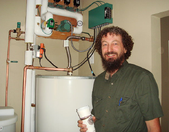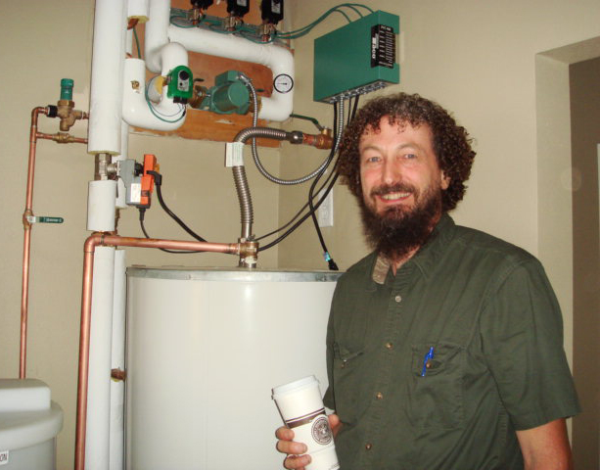Habitat for Humanity Home Utilizes CCV Valves for Energy Efficient Design
Habitat for Humanity in Riverside, CA has raised the bar on energy efficient residential design with a unique system that uses one heat source — a tankless boiler — for both domestic hot water and radiant floor heating. Peter “Rugg” Lehrbass, a Facilities & Planning Services engineer at California Baptist University was called upon and volunteered his design services for the Habitat home, which is on track to become Habitat’s first LEED platinum certified home. While gas fired tankless water heaters have become extremely popular for efficient hot water delivery, Lehrbass, using his solar integration & automation controls experience, took the idea a step further by using a tankless boiler to incorporate space heating as well.
boiler — for both domestic hot water and radiant floor heating. Peter “Rugg” Lehrbass, a Facilities & Planning Services engineer at California Baptist University was called upon and volunteered his design services for the Habitat home, which is on track to become Habitat’s first LEED platinum certified home. While gas fired tankless water heaters have become extremely popular for efficient hot water delivery, Lehrbass, using his solar integration & automation controls experience, took the idea a step further by using a tankless boiler to incorporate space heating as well.
Belimo Actuators and Valves are a critical part of this overall design as they maintain low restriction & accurate flow through a dual flow primary (domestic hot water) loop and a secondary (floor heating) loop. Lehrbass’ design specified two Belimo 3-way characterized control valves and actuators.
The challenge was to design a system that was within both LEED and Habitat-for-Humanity guidelines.
"We wanted to prove that it is possible to build a house that is both affordable and green," said Lehrbass. "As an affordability consideration, the combining of the two systems allowed us to roll the equipment cost savings of using a single boiler toward the materials cost of a hydronic floor, making it viable against the originally planned systems cost."
The functionality of the design necessitated accurate flow and temperature control which led to the Belimo selection. “The Belimo product gave us the ability to effectively combine and control the two systems,” said Lehrbass.
The Habitat design incorporates a 199,000 btuh natural gas-fired fully-modulating Noritz ASME rated tankless boiler, a Bradford White all stainless steel Indirect Domestic Water Heater (IDWH) with dual internal heat exchanger coils & a 3-zone REHAU radiant floor heat system.
The system is designed to operate in one of five modes.
This operation allows the fastest recovery time of domestic hot water. When the temperature inside the IDWH tank drops to 10 degrees below the 120 degree setpoint, flow rate through the boiler increases (P-1) and operates at a high 180 degree setpoint. During this mode (V-1), a Belimo 3-way 2-position characterized control valve with position end-switches, directs water through both indirect heat exchanger coils. (A future separate solar hydronic heat source can be connected using the lower coil with the top coil as a “boiler back-up” source.)
Low Domestic Water Demand Only
When the IDWH demand drops to 5 degrees below the 120 degree setpoint, the boiler operates at both a lower flow (P-2) and priority setpoint capacity of 140 degrees, minimizing gas consumption when DW demand is low and allowing accurate temperature cut-off without overshoot.
Low Domestic Water Demand with a Space Heating Demand
This mode is activated when there is a need for both heating and domestic hot water. The boiler operates at the low priority setpoint of 140 degrees, supplying the hottest water to the IDWH first. However, because the leaving water temperature through the IDWH internal heat exchanger will be no less than 110 degrees, there is enough heat to provide space heating loop operation as well.
Space Heating Demand Only
When the IDWH thermostat is completely satisfi ed, the Belimo valve (V-1) repositions to allow the primary loop flow to bypass the IDWH. An end switch closure signals low priority boiler and floor loop operation based on a space heating demand only. The floor loop temperature is regulated by modulating Belimo 3-way valve (V-2) for accurate mixing of primary loop water into the secondary (floor heating) loop. The valve operation allows floor loop temperature to be controlled between 80 and 110 degrees, based on an outdoor air temperature reset schedule for additional operational savings.
No Domestic Water or Space Heating Demand (System Standby)
Flexibility was one of the main reasons Lehrbass selected the Belimo valves. During the design stages he did not know what control signals would be required by the valves, but he did know that Belimo control valves can be re-programmed at the jobsite to respond to the correct control signal, whether it is any VDC range, proportional, floating point, on-off, feedback signal.
"When we perform system start-up and commissioning, we’ll be able to see what signal comes from the floor heat controller, and using the inexpensive Belimo configuration software on my laptop, we’ll program the valve actuator to respond correctly to that signal," said Lehrbass, who has specified Belimo products at California Baptist University because of their high quality & inherent flexibility. "By using Belimo MFT, we can stock just a few sizes of replacement actuators, and be covered, for any air or water control application, since they can be individually programmed," said Lehrbass.
Lehrbass is also a fan of Belimo's characterized control design. As with all CCVs, the valves that Lehrbass chose for this project have a special characterizing disc inside the valve that give it an equal percentage characteristic that is typically only associated with more expensive globe valves. A rotating, rather than a rising stem motion helps maintain a leak-free valve service life.
“We were delighted to be a part of the Habitat project in Riverside,” remarked Sue Ramirez, Area Sales Manager for Belimo. “Habitat for Humanity is not only a wonderful cause, the LEED component provides a wonderful forum to showcase energy saving technology - like characterized control valves with MFT.”
Using a single high efficiency tankless heat source for both domestic water and space heating will enable Habitat for Humanity to acquire LEED points for the home under the categories of Energy & Atmosphere and Innovation in Design categories pushing the project into the LEED Platinum status.

